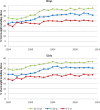Childhood obesity trends from primary care electronic health records in England between 1994 and 2013: population-based cohort study
- PMID: 25633067
- PMCID: PMC4345834
- DOI: 10.1136/archdischild-2014-307151
Childhood obesity trends from primary care electronic health records in England between 1994 and 2013: population-based cohort study
Abstract
Objective: This study aimed to use primary care electronic health records to evaluate the prevalence of overweight and obesity in 2-15-year-old children in England and compare trends over the last two decades.
Design: Cohort study of primary care electronic health records.
Setting: 375 general practices in England that contribute to the UK Clinical Practice Research Datalink.
Patients: Individual participants were sampled if they were aged between 2 and 15 years during the period 1994-2013 and had one or more records of body mass index (BMI).
Main outcome measure: Prevalence of overweight (including obesity) was defined as a BMI equal to or greater than the 85th centile of the 1990 UK reference population.
Results: Data were analysed for 370 544 children with 507 483 BMI records. From 1994 to 2003, the odds of overweight and obesity increased by 8.1% per year (95% CI 7.2% to 8.9%) compared with 0.4% (-0.2% to 1.1%) from 2004 to 2013. Trends were similar for boys and girls, but differed by age groups, with prevalence stabilising in 2004 to 2013 in the younger (2-10 year) but not older (11-15 year) age group, where rates continued to increase.
Conclusions: Primary care electronic health records in England may provide a valuable resource for monitoring obesity trends. More than a third of UK children are overweight or obese, but the prevalence of overweight and obesity may have stabilised between 2004 and 2013.
Keywords: Epidemiology; Growth; Monitoring; Obesity.
Published by the BMJ Publishing Group Limited. For permission to use (where not already granted under a licence) please go to http://group.bmj.com/group/rights-licensing/permissions.
Figures
References
Publication types
MeSH terms
LinkOut - more resources
Full Text Sources
Other Literature Sources
Medical


